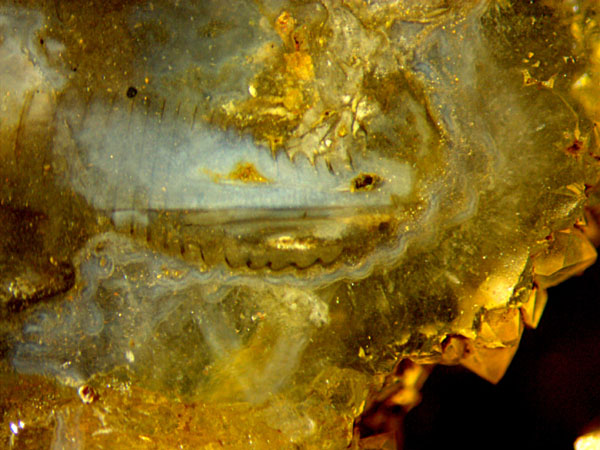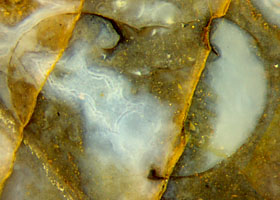Crustacean and crystal
 Crustacean and crystal have got something in common here:
Either has grown in water. This may be surprising to those who
subconciously adhere to the old-fashioned terms of "animal kingdom" and
"mineral kingdom", and relate the latter to the idea of old
age and high
temperature of formation. This does not apply here since
the well-shaped quartz crystals had formed much later than
silicification
had turned the
crustacean moult into a "fairy
bathtub" (Fig.1). The illusion of a seashell
as a bathtub, a favourite motiv of painters, is brought about here by
the level boundary suggesting the idea of water and steam.
As mentioned in connection with similar phenomena, levels of
such kind do not indicate a former water surface. They indicate a
former interface between water and a watery suspension. (See Rhynie
Chert News 142,
143,
144,
145.)
Crustacean and crystal have got something in common here:
Either has grown in water. This may be surprising to those who
subconciously adhere to the old-fashioned terms of "animal kingdom" and
"mineral kingdom", and relate the latter to the idea of old
age and high
temperature of formation. This does not apply here since
the well-shaped quartz crystals had formed much later than
silicification
had turned the
crustacean moult into a "fairy
bathtub" (Fig.1). The illusion of a seashell
as a bathtub, a favourite motiv of painters, is brought about here by
the level boundary suggesting the idea of water and steam.
As mentioned in connection with similar phenomena, levels of
such kind do not indicate a former water surface. They indicate a
former interface between water and a watery suspension. (See Rhynie
Chert News 142,
143,
144,
145.)
Fig.1: Crustacean moult with fancy fill, cavity with quartz crystals.
Frame width 4.3mm.
The moult with the silica-rich
swamp water inside provided
a nearly closed compartment where silica clusters formed and settled into
a suspension. Continuing influx of silica by
diffusion finally turned the shell with content and surroundings,
except the big cave below right, into
solid chalzedony.
Most probably the moult belongs to the crustacean Castracollis named
after the farm Castlehill near Rhynie and first published in 2003 [1].
Another moult part (Fig.2), found on the same cut face of the sample,
supports the assumption.

Fig.2: Castracollis
head
shield, cut across its rather involved 3D-shape. Frame width 2mm, same
scale as Fig.1.
Apparently the 3D-shape of the shield on the front part known as head
shield is not readily imaginable as a whole. In Fig.2, clear chalzedony offers a spatial aspect of the strongly incurved edge above.
As expected, the contours of the few
random cuts available differ among themselves, and they do not seem
compatible with the reconstruction of the creature in [1].
(See Rhynie
Chert News 24.)
A tiny detail in Fig.2 confirms that the object is really of organic origin: The
yellow crack on the right is deflected around the
strongly curved part of the moult (above), which means that the moult offers an easy crack path.
The cavity with quartz
crystals in Fig.1 requires an explanation. In a swamp, gas bubbles
ascend or become trapped. If the swamp water is rich in silica,
beginning silicification of the surrounding water and swamp matter can
stabilize the bubbles. Later
on, the gas escapes and water saturated with silica enters by
diffusion through the silica gel. Constant conditions with slight
supersaturation gave rise to slow growth of regular quartz crystals over a
long time. Later on the water disappeared and left the cavity as we see
it now.
Sample:
Rh6/53, found by S.
Weiss
in 2003, this Part 8
(end) given to Barron.
H.-J.
Weiss 2019
[1] S.R. Fayers,
N.H. Trewin: A new crustacean from the Early
Devonian Rhynie Chert ...
Trans.Roy. Soc. Edinburgh,
Earth Sci.
93(2003), 355-382.
 |
 |
147 |


 Crustacean and crystal have got something in common here:
Either has grown in water. This may be surprising to those who
subconciously adhere to the old-fashioned terms of "animal kingdom" and
"mineral kingdom", and relate the latter to the idea of old
age and high
temperature of formation. This does not apply here since
the well-shaped quartz crystals had formed much later than
silicification
had turned the
crustacean moult into a "fairy
bathtub" (Fig.1). The illusion of a seashell
as a bathtub, a favourite motiv of painters, is brought about here by
the level boundary suggesting the idea of water and steam.
As mentioned in connection with similar phenomena, levels of
such kind do not indicate a former water surface. They indicate a
former interface between water and a watery suspension. (See Rhynie
Chert News 142,
143,
144,
145.)
Crustacean and crystal have got something in common here:
Either has grown in water. This may be surprising to those who
subconciously adhere to the old-fashioned terms of "animal kingdom" and
"mineral kingdom", and relate the latter to the idea of old
age and high
temperature of formation. This does not apply here since
the well-shaped quartz crystals had formed much later than
silicification
had turned the
crustacean moult into a "fairy
bathtub" (Fig.1). The illusion of a seashell
as a bathtub, a favourite motiv of painters, is brought about here by
the level boundary suggesting the idea of water and steam.
As mentioned in connection with similar phenomena, levels of
such kind do not indicate a former water surface. They indicate a
former interface between water and a watery suspension. (See Rhynie
Chert News 142,
143,
144,
145.)


